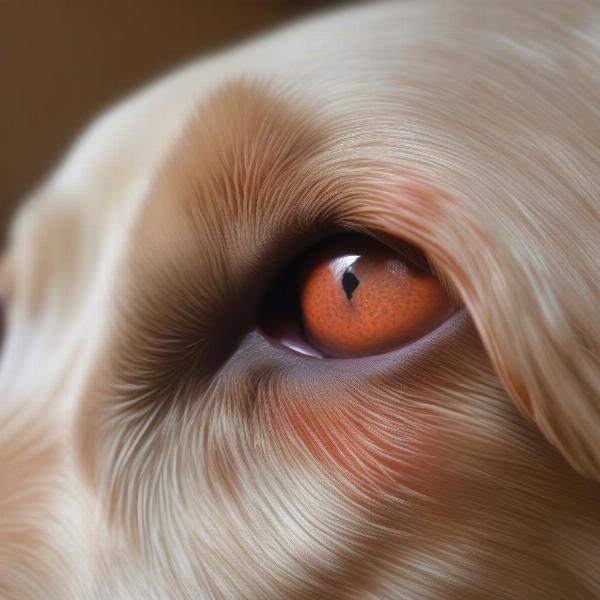Harvest mites, those tiny orange specks that can cause so much discomfort for our canine companions, are a common concern for dog owners. Identifying these minuscule arachnids can be tricky, especially since they’re often mistaken for dirt or other debris. This article will guide you on how to identify harvest mites on your dog, understand the problems they cause, and discover effective treatment and prevention strategies.
Identifying Harvest Mites on Dogs
Harvest mites, also known as Trombicula alfreddugesi, are barely visible to the naked eye. They’re reddish-orange and tend to cluster in areas where your dog’s skin is thin and fur is sparse, such as the ears, paws, face, and groin. Look closely for tiny, moving dots, especially after your dog has been in grassy or wooded areas. You might notice your dog excessively licking, scratching, or biting at these areas due to the intense itching caused by the mites’ bites.
 Harvest mites on a dog's ears
Harvest mites on a dog's ears
The key to identifying harvest mites is their distinct color and location. While other parasites might resemble them, the bright orange hue of harvest mites is a crucial identifier.
Problems Caused by Harvest Mites
Though tiny, harvest mites can cause significant discomfort for your dog. Their bites inject a digestive enzyme into the skin, causing intense itching, inflammation, and hair loss. In severe cases, secondary infections can develop from excessive scratching.
While generally not life-threatening, untreated infestations can lead to significant discomfort and skin issues. It’s essential to address the problem promptly to alleviate your dog’s suffering.
Treating and Preventing Harvest Mite Infestations
Several treatments are available to combat harvest mites. Your veterinarian can prescribe medicated shampoos, sprays, or spot-on treatments to kill the mites and relieve itching. Regularly checking your dog for mites, especially after walks in grassy areas, is crucial for early detection and treatment.
Preventing infestations is also essential. Keeping your dog’s fur trimmed short, especially around the paws and ears, can make it harder for mites to latch on. You can also use preventative sprays or wipes containing natural repellents before walks in high-risk areas.
Dr. Emily Carter, a veterinary dermatologist at the Animal Dermatology Clinic in London, advises, “Regular grooming and the use of preventative products can significantly reduce the risk of harvest mite infestations. Early detection and treatment are crucial for minimizing discomfort and preventing secondary infections.”
Conclusion
Harvest mites are a nuisance for dogs, but with vigilance and proper care, you can effectively manage and prevent infestations. Regularly checking your dog, using preventative measures, and seeking veterinary advice when needed will ensure your furry friend remains happy and healthy, free from the irritation of these tiny pests.
FAQ
- What do harvest mites look like on dogs? They appear as tiny, bright orange specks, often clustered in areas with thin fur.
- Are harvest mites harmful to dogs? While not life-threatening, their bites cause intense itching and can lead to skin irritation and secondary infections.
- How can I treat harvest mites on my dog? Consult your veterinarian for appropriate medicated shampoos, sprays, or spot-on treatments.
- How can I prevent harvest mite infestations? Keep your dog’s fur trimmed, use preventative sprays, and avoid high-risk areas during peak season.
- Can humans get harvest mites from dogs? While rare, humans can also be bitten by harvest mites, experiencing similar itching and irritation.
- When are harvest mites most active? They are typically most prevalent in late summer and autumn.
- What should I do if I suspect my dog has harvest mites? Consult your veterinarian for a proper diagnosis and treatment plan.
ILM Dog is a leading international online resource dedicated to providing expert advice on dog care and well-being. We cover everything from breed selection and health care to training, nutrition, grooming, and more. Our mission is to empower dog owners with the knowledge and resources they need to provide the best possible care for their canine companions. Whether you’re a seasoned dog owner or just starting your journey, ILM Dog is your trusted source for reliable, practical advice. For personalized guidance or any questions, contact our expert team at [email protected] or +44 20-3965-8624.